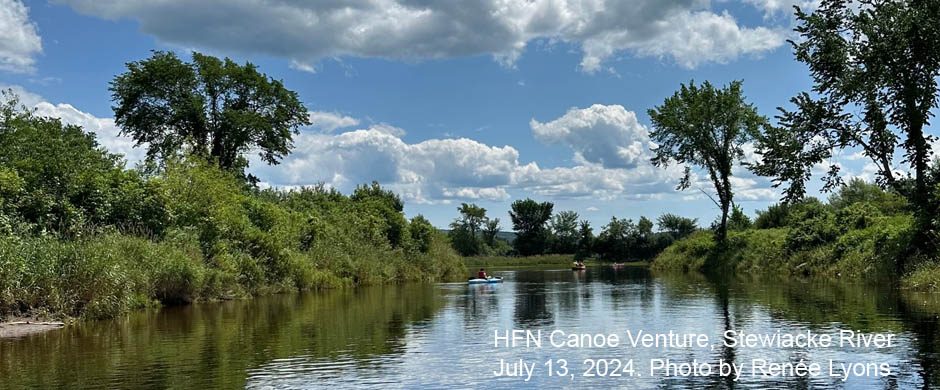
A wild cherry in bloom at PPP May 19, 2019. What will change at this site, and others, after the cull?
UPDATE: Advocacy group concerned about culling of trees in Point Pleasant
by: Victoria Walton FOR www.halifaxtoday.ca/ “The Friends of Point Pleasant Park group wants more information on the proposed cull of 80,000 non-native trees in the park”. The 95.7 Interview with Stephanie Robertson can be accessed for a limited time under past episodes. The Rick Howe Show – 9 a.m. for May 21, 2019; The interview begins at ~9:45.
——–
The tree cull planned for Point Pleasant Park is raising some alarms, view links below.
Stephanie Robertson of the Halifax Field Naturalists will be talking about it on Tues 21 May 2019 at 11 am on The Rick Howe Show.
If you miss it, you can catch the audio recording for a couple of days here. Stay Tuned!
More on the Cull
– Forestry expert advises caution in Point Pleasant Park tree cull
Pam Berman · CBC News · Posted: May 13, 2019
–Massive tree cull in Point Pleasant Park planned for this summer
Paul Palmeter · CBC News · Posted: May 07, 2019
– Summer tree-thinning at Halifax’s Point Pleasant Park part of post-Juan plan
by John McPhee in the Chronicle Herald Apr 8, 2019
Intensive tree cull in Halifax’s Point Pleasant Park delayed until after nesting season; Nova Scotia L&F continues to ignore federal regs 12May2019
Post on nsforestnotes.ca, May 12, 2019
Related:
– Point Pleasant Park Comprehensive Plan (2008)
– Does Time Heal All Wounds? The Restoration of Place Attachment after Loss of Place: The case study of Point Pleasant Park after Hurricane Juan
MA thesis by Patrick Charles Lewis Larter, SMU, 2016
– Multiflora Rose in Point Pleasant Park, Halifax
I have some concerns about further spread of invasive Rosa multiflora: if it is not addressed concurrently with the cull, it will take over wetlands and climb over trees at edges. (See also Multiflora rose, an invasive that crept up on us in Halifax, NS)
——
From the Tender
APPENDIX A – RFQ DELIVERABLES
Area to be treated in 2019 is 10.63 ha. and comprises 5 separate blocks. See maps below.
Work to be completed prior to July 31, 2019.
Specifications for Spacing/Thinning in Point Pleasant Park:
1) To uniformly thin by means of clearing/thinning saws, leaving the trees listed in item (7) at a target spacing of 2.5m x 2.5m (8′ x 8′) approximately 1600 stems/ha., varying slightly to leave the best tree.
2) All stem cuts are to be left with a horizontal finish cut completely through, and stumps shall be 7.5 cm (3″) or less in height.
3) Trees/brush to be cut and dispersed with most of their surface area in contact with the ground.
4) Brush shall be pulled back from wet areas (streams, vernal pools, ponds, etc…).
5) Brush is not to be left within 10 Metres of a park roadway, and not within 5 meters of foot paths. Brush shall be pulled further back into the woods and dispersed or may be chipped and blown back into the forested area.
6) The following trees shall be cut regardless of spacing;
Norway Maple (Acer platanoides)
Sycamore Maple (Acer pseudoplatanus)
Silver Maple (Acer saccharinum)
Norway Spruce (Picea abies)
Sitka Spruce (Picea sitchensis)
Scots/ Scotch pine (Pinus sylvestris)
Austrian Pine (Pinus nigra)
Douglas Fir (Pseudotsuga menziesii)
English Oak (Quercus robur)
Horse Chestnut (Aesculus hippocastanum)
Locust (Robinia spp.)
7) Acadian Forest Species shall be left using the following species hierarchy;
White Pine (Pinus strobus)
Red Oak (Quercus rubra)
Eastern Hemlock (Tsuga canadensis)
Sugar Maple (Acer saccharum)
Yellow Birch (Betula alleghaniensis)
Aspen (Populus spp.)
*** All other Acadian species shall have equal priority and shall be spaced, accommodating for diversity of species within a given area.
8) When stump sprouts are the tree of choice, the 2-3 sprouts with best form and dominance will be left.
9) Inferior quality stems are to be removed even if a less desirable species is left in its place.
HRM will perform quality checks to determine if the work was completed to treatment objectives and standards.
Contractor to provide post-treatment plot data to consist of species composition, density, height and age. Number of plots required: 2 per ha. and are to be randomly selected. Actual area treated to also be submitted.
Contractor to have firefighting equipment on site as per NS Forest Fire Protection Regulations.
